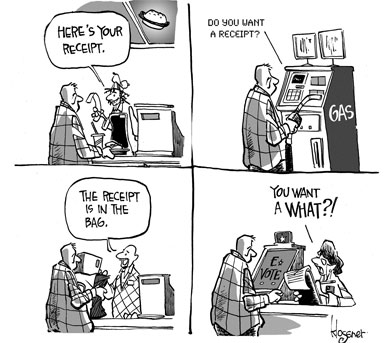Editorial: E-voting: The need for paper

Information technology has an important role to play in voting, particularly after the 2000 presidential vote and the infamous hanging chads.
Few things are more fundamental to a democracy than the right to vote. Given technology’s ability to help organizations operate better, faster and more efficiently, information technology has an important role to play in voting, particularly after the 2000 presidential vote and the infamous hanging chads. The Help America Vote Act of 2002 pushed states to undertake what most consider to be the largest overhaul of voting equipment in the country’s history.
In its Nov. 6 issue, Time magazine correctly pointed out that there is a misconception that elections were perfect “PC” — pre-computer. They weren’t, and they can and should be improved.
Unfortunately, six years after the 2000 presidential election and four years after the Help America Vote Act, people seem more concerned than ever about the validity of elections. Electronic voting systems have not moved us closer to the goal of improving the public’s faith in fair and accurate elections.
To the contrary, e-voting systems have become such an issue that Maryland Gov. Robert Ehrlich suggested returning to paper ballots after the state faced many problems with e-voting systems during primaries. “When in doubt, go paper, go low-tech,” he said.
In many ways, the development of e-voting systems is a test case for what not to do when developing systems.
Problems abound with e-voting systems. Many people question their security. Others worry about the lack of training for poll workers who will need to keep those machines running.
But for us, the most inconceivable part of e-voting is the resistance to paper receipts. Ed Felten, a Princeton University professor who recently co-authored a report on the vulnerabilities of direct-recording touch-screen electronic systems, has argued that paper receipts would give voters a tangible record of their intent — receipts that software cannot alter. Receipts provide a backup record to use in recounts and audits.
Inexplicably, many e-voting systems manufacturers have resisted or rejected the call for paper receipts. However, 28 states either use optical scan systems, which have paper ballots or require printers for touch-screen machines. The simple addition of a paper receipt would be a huge step toward addressing citizen concerns about e-voting.
Everyone must focus on the goal. The goal isn’t using electronic systems. The goal isn’t even to count the votes more efficiently, although that would be beneficial. The goal — as lofty as it sounds — is to create a system that enhances people’s confidence that their voice is being heard and reassures their faith in democracy. Paper audit trails are an obvious path toward that goal.

NEXT STORY: EPA official tries to allay library fears


